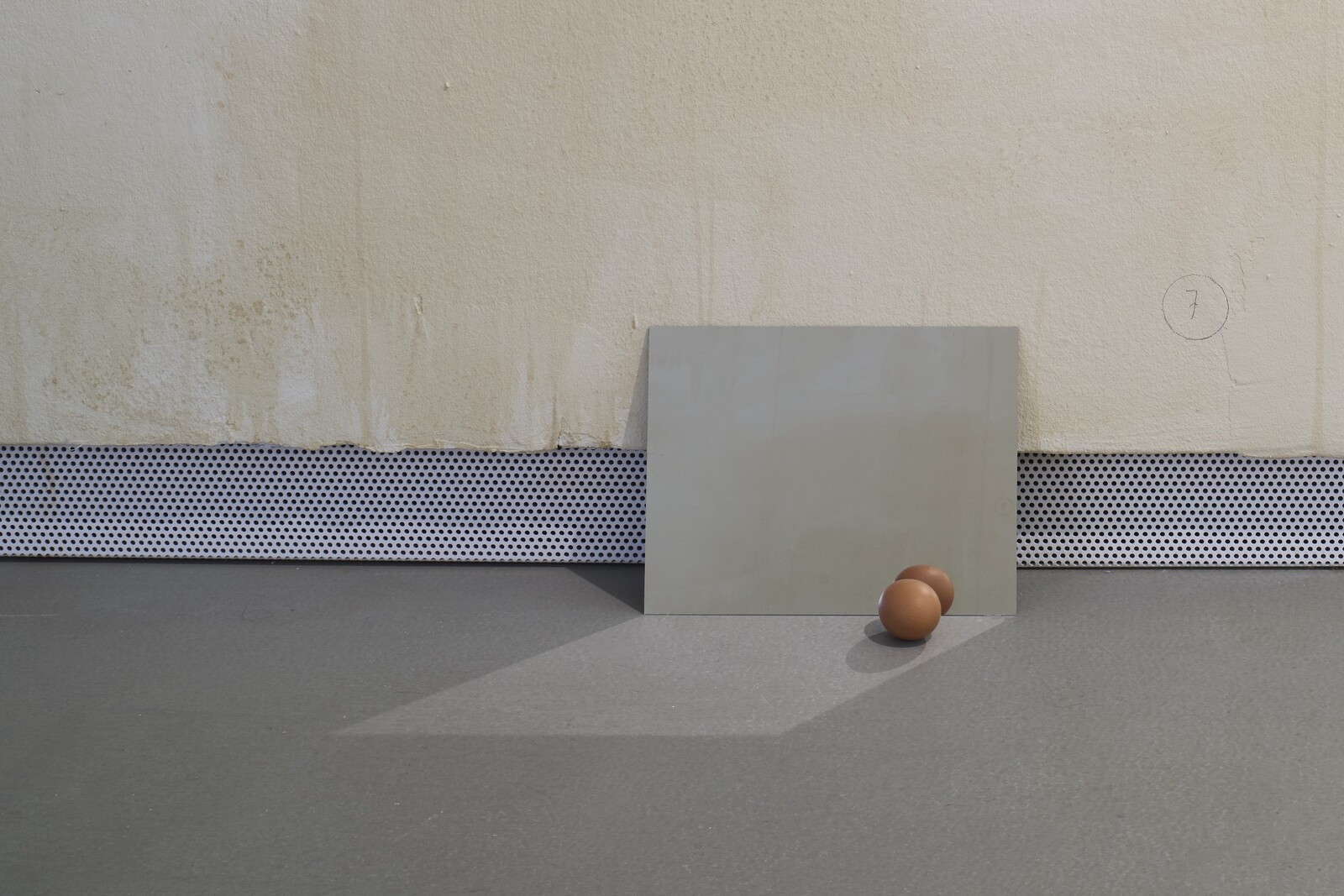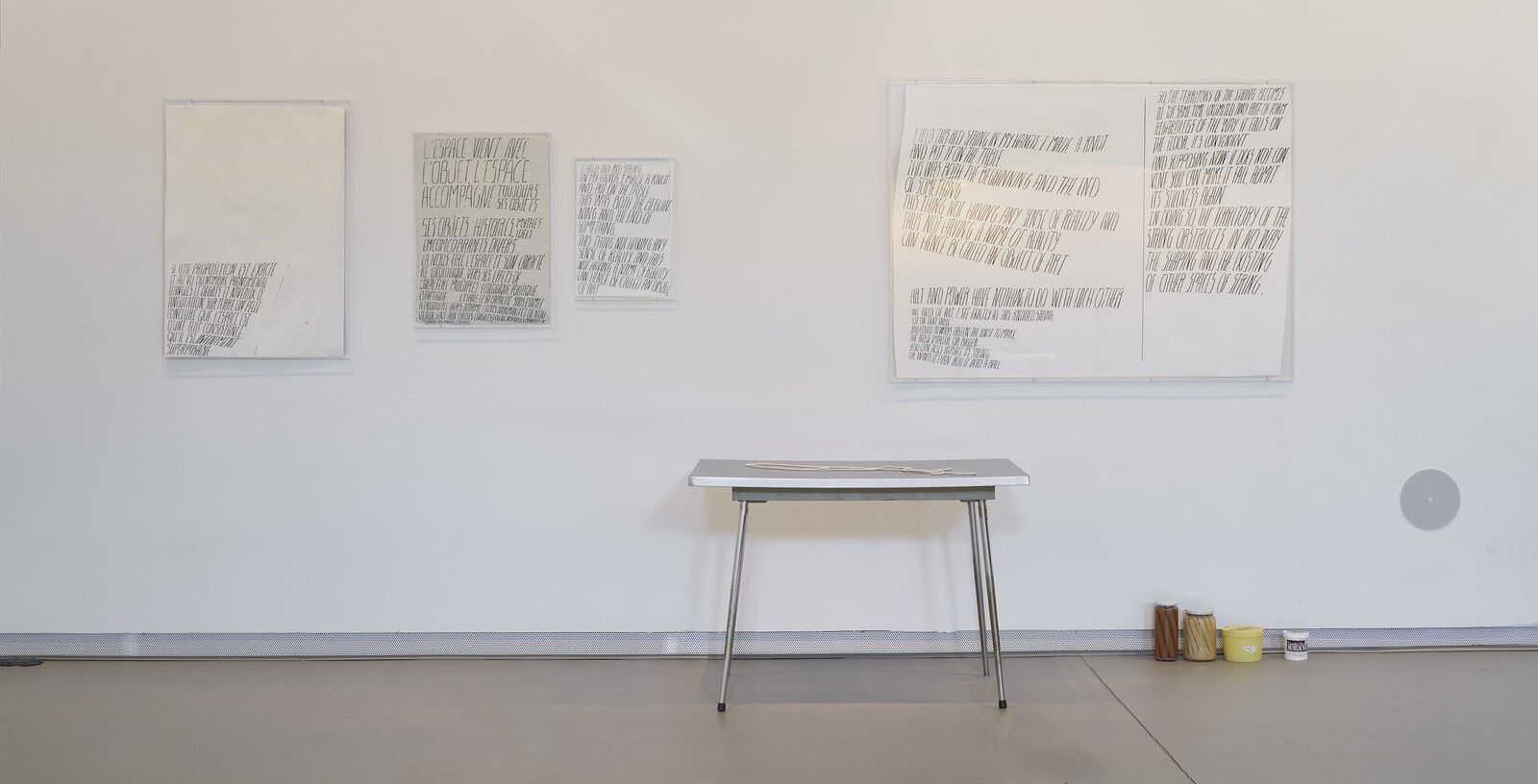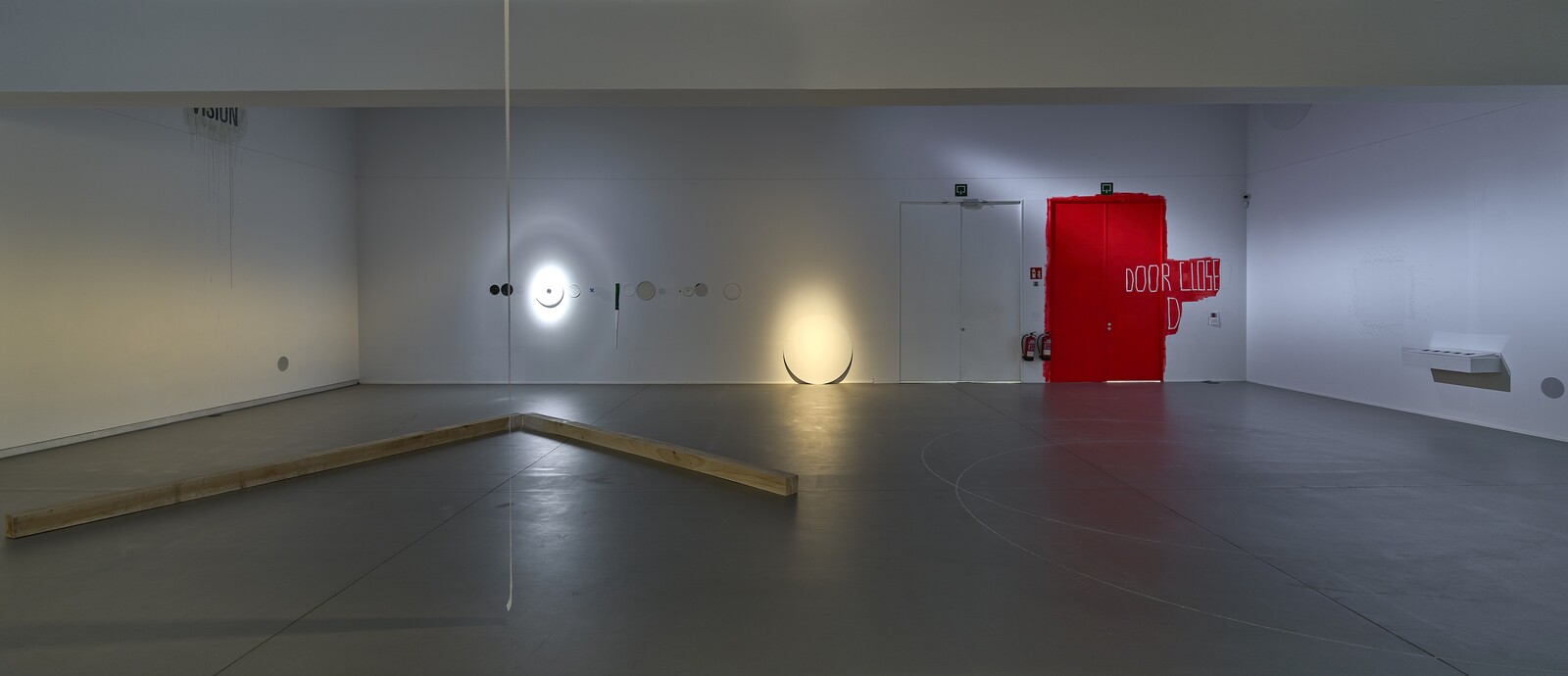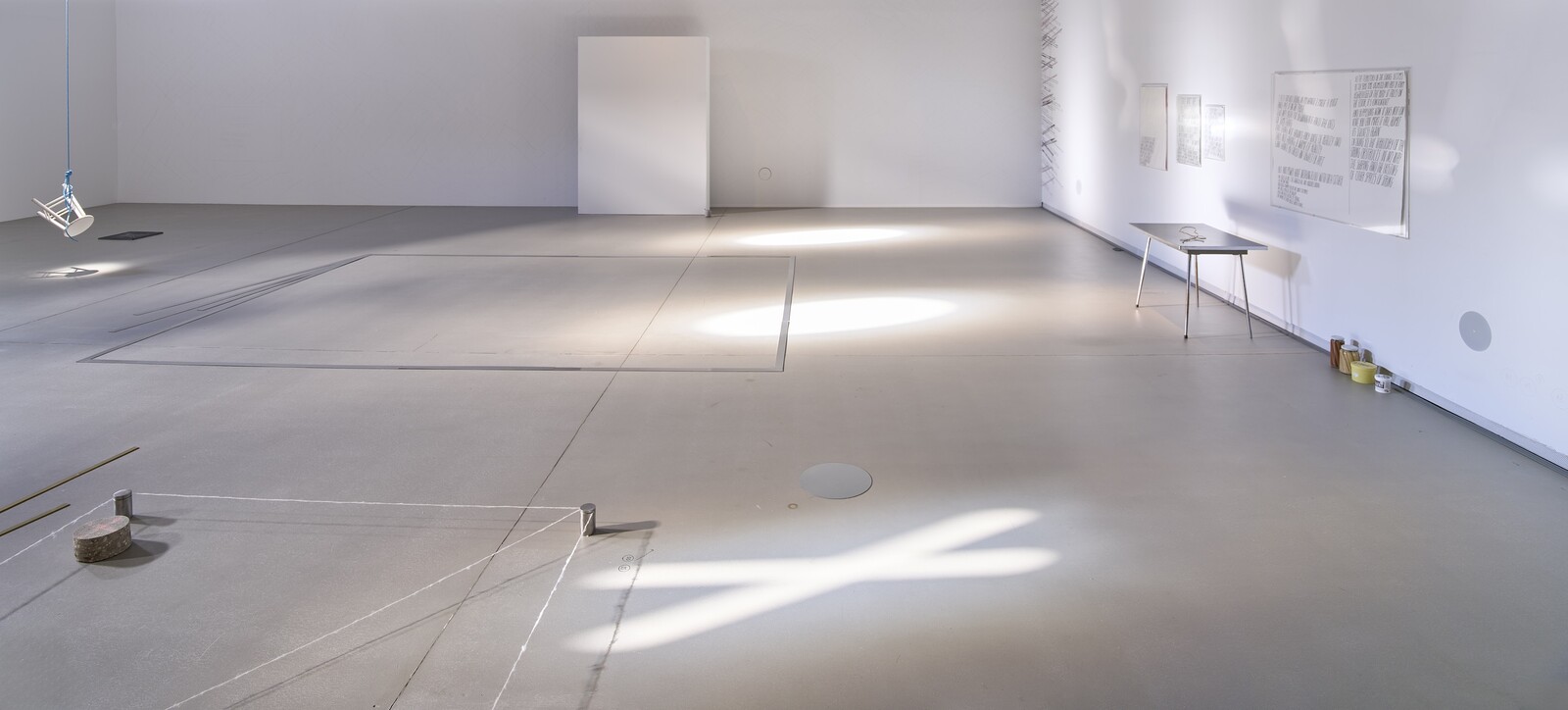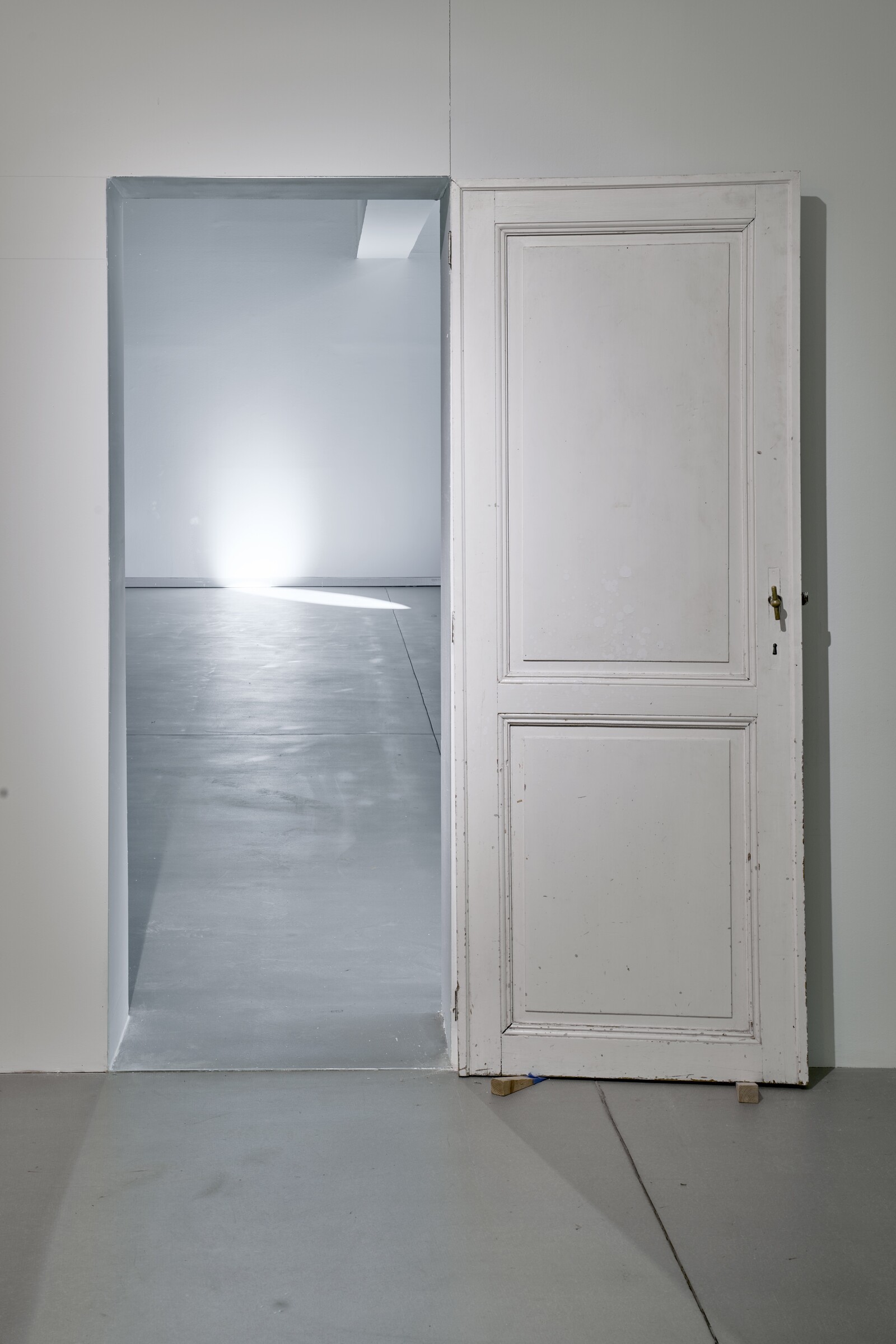November 15, 2024–April 27, 2025
The first work the viewer encounters is a large cardboard maquette of the show they have just stepped into, complete with scale models of artworks, including one of the maquette itself, and crude cardboard miniatures of museumgoers like them. Maqueta ‘El caso de l(a casa) museo(a)’ (2024) signals from the outset that Belgian artist Joëlle Tuerlinckx intends to subvert not only viewers’ expectations, but the apparatus of exhibition-making.
Across the museum’s six subterranean galleries, lights turn off and on at random-seeming intervals. Holes are cut into the walls. A room is rendered inaccessible by a sheet of Plexiglass. A printed text, affixed to the wall beside a fire exit haphazardly covered in lurid red paint, might have been written by a sentient fire alarm: “Hello dong ding dong drriiiing,” it says. Such interventions are in keeping with the spirit of early works such as Dacht en Nacht.MUSEUM OPEN 24/24 (1997), in which the artist opened a museum for 24 hours, with bright lights at night and darkness during the daytime. At once disorienting, atmospheric, and tongue-in-cheek, Tuerlinckx’s works heighten the viewer’s awareness of how the meaning ascribed to art is conditioned by the contexts in which it is encountered. But where exactly do those contexts begin and end?
Curated by Beatriz Herráez and Catalina Lozano, this is a richly atmospheric, densely layered show. It chiefly consists of precise arrangements of found objects (tubs of screws and museum wax, plastic plates, an unopened package wrapped in black plastic) and minimalist sculptures (a black cube encased in Perspex, positioned near that unopened package; a tall white pole resting against a transparent wire). There are spatial interventions, wall-drawings, a video depicting hands, perhaps the artist’s, methodically blotting out a page with felt-tip pen. It all adds up to more than the sum of its deadpan parts.
This is largely thanks to a multilingual sound work, written by the artist and composed and edited by Christoph Fink, that echoes throughout the spaces. Short, ruminative texts, spoken in Basque, English, French, and Spanish and interrupted by the occasional snippets of music, lend the space a sonic texture akin to a train terminus frequented by murmuring intellectuals. Some seem to reference the works directly. “In the beginning, I had this rope in my hands,” says a voice beside a table on which a knotted rope is laid. “I tied it in a knot.”
If Tuerlinckx doesn’t quite turn the gallery inside-out, she disrupts how it is typically experienced. In one corner, an undated work consisting of a stack of local newspapers—I initially mistook them for invigilators’ reading materials, which, kind of double take, might be part of the point—suggests a porousness between the gallery and the external world. Cut into a stud wall near Maqueta, two small, circular holes (Trou de mur recto and verso, 1995/2024) allow the viewer to spy, Peeping Tom–like, the larger gallery next door. In this second space, lines drawn on the floor and walls, a spotlit distance-measuring wheel, plastic rulers, and fragments of spoken text beg the question of what exactly is being measured, and according to whose criteria.
In the third and largest room, with its high ceilings and circular windows, squares and rectangles are outlined on the floor in metal, shredded documents, string, and text (“EVERYTHING YOU SEE HERE,” reads one, “DOES NOT EXISTE” [sic]). Dotted here and there are sculptures, such as a spotlit stool hanging on a blue rope, with sketchy wall-drawings (scratchy marks, an Agnes Martin-style grid) by turns hard-to-read and crisply legible as the lighting turns off and on. The overall impression is of a constellation of clues, at once ephemeral and highly charged.
“El caso de l(a casa) museo(a)” is a retrospective with the feel of a new, cohesive installation. It contains works (and constituent elements thereof, such as jars of faded hot dogs and white asparagus visibly past their sell-by date) that date back several years, some all the way to the nineties. Tuerlinckx reconfigures her work in response to the spaces in which she exhibits. As underscored by an accompanying booklet dense with illustrations and text yet lacking staples to hold it together, in which works are sub-divided into “cases,” her art seems to operate as a continuous, endlessly self-referential process, in which no work ever stands in fixed, permanent relation to any other. (An international trio of retrospective exhibitions in 2013 was collectively titled “WORLD(K) IN PROGRESS?”) Meaning emerges from systems of relation that are specific and temporary.
One frustration of rigorously unspectacular work of this kind can be the sense that this same meaning, however vivid to the artist, can be inaccessible to viewers for whom a jar of hot dogs is simply that. Yet this exhibition constantly undermines the idea of any fixed, overarching authority, creating room for the viewer to join the dots. The lightness of Tuerlinckx’s approach extends both to her chosen materials (paper, cardboard, string, sound) and their surprisingly funny effects (several pieces, including an egg apparently contemplating its own reflection in a mirror, prompted me to laugh). In a testament to the show’s visual austerity and deadpan humor, only once I was a few feet away from Chute de plafond ‘Clouds’ (2013–23), a long, white strip hanging almost all the way from ceiling to floor, did I realize that this elegant sculpture was made from toilet roll.
Returning to Maqueta at the end of the exhibition (viewers enter and leave through the same set of doors) confirmed my suspicion: several works are missing from the model, while others appear in different form, when miniaturized, than in the gallery. The dissonance between model and exhibition—for which we might substitute map and territory, or language and world—is entirely deliberate. No system of meaning, however meticulously ordered, is ever perfectly self-contained. The unstable terrain between art and its environment, Tuerlinckx suggests, might be where exhibitions actually happen.
